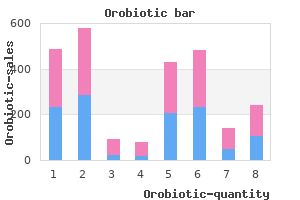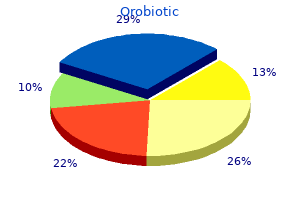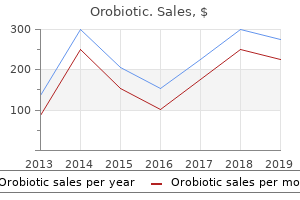


OLSSON'S IS CLOSED
Thank you to all our loyal customers who supported us for 36 years
"Orobiotic 100 mg visa, infection 6 weeks after c section".
By: W. Frithjof, M.B. B.CH., M.B.B.Ch., Ph.D.
Co-Director, University of Chicago Pritzker School of Medicine
This binding interferes with the coil-coil interaction required to approximate the viral envelope and the host cell membrane in the course of the strategy of viral fusion antibiotics for dogs diarrhea cheap orobiotic 250mg with mastercard. In two impartial studies antibiotics for uti liquid order orobiotic on line amex, patients who had persistent viremia regardless of prior treatment with brokers from all three available lessons of medicine have been randomized to receive an individualized routine (based on prior remedy historical past and resistance profile) with or with out enfuvirtide antibiotic resistance usda discount orobiotic 250mg. Among the drawbacks of this agent are the requirement for twice-a-day injection bacteria names purchase orobiotic 250 mg with visa, the incidence of injection-site reactions in close to 100 percent of sufferers, and an increase in bacterial pneumonia within the enfuvirtide-treated sufferers compared with the management patients (4. The license was extended in 2009 to include treatment-na�ve sufferers with R5 virus. A coreceptor tropism assay must be performed if one is considering the usage of maraviroc to ensure that the potential affected person is only harboring R5 viruses. Among the most typical unwanted side effects of maraviroc are dizziness due to postural hypotension, cough, fever, colds, rash, muscle and joint ache, and abdomen pain. In combination with nucleoside analogues, tipranavir/ritonavir, enfuvirtide, and/or nevirapine, the dose is 300 mg twice day by day. They are among the many most potent and safest of the antiretroviral medicine and frequently a part of initial combination regimens. The three licensed integrase inhibitors are raltegravir, elvitegravir and dolutegravir. As with a number of other compounds, resistance to raltegravir comes at the expense of replicative health. In contrast to many other antiretroviral drugs the side-effect profile of raltegravir is minimal, with comparable side-effect profiles noted for the raltegravir and placebo groups. Elvitegravir is an integrase inhibitor that was accredited in 2012 as a half of a fixed-dose combination pill also containing tenofovir, emtricitabine, and cobicistat (Stribild). In two randomized, managed trials, elvitegravir was discovered to be noninferior to efavirenz in a single examine and noninferior to atazanavir/ritonavir within the different. The most common side effects skilled with elvitegravir are diarrhea, nausea, higher respiratory an infection, and headache. Dolutegravir was permitted in 2013 to be used as part of a combination routine in both treatment-na�ve or -experienced sufferers. It comes as a 50-mg tablet and is given as soon as daily in treatment-na�ve sufferers and twice day by day in treatment-experienced patients. In two randomized, controlled trials it has been proven to be superior to both efavirenz (n = 833) or darunavir/ ritonavir (n = 484) together with nucleos(t)ide analogues due to lower charges of discontinuation. His conditioning regimen included cytotoxic chemotherapy, total-body irradiation, and antithymocyte immunoglobulin. Treatment choices should take into account the fact that one is dealing with a persistent an infection that requires day by day remedy. Patients initiating antiretroviral therapy should be keen to commit to life-long treatment and understand the significance of adherence to their prescribed routine. Maximal suppression of viral replication is a objective of therapy; the higher the suppression the less likely the appearance of drug-resistant quasispecies. The antiretroviral drugs used in combination regimens should be used in accordance with optimum schedules and dosages. This delay might decrease the severity of any subsequent immune reconstitution inflammatory syndrome by reducing the antigenic burden of the opportunistic an infection. Given that patients could be contaminated with viruses that harbor drug resistance mutations, it is suggested that a viral genotype be accomplished previous to the initiation of therapy to optimize the choice of antiretroviral brokers. The combination regimens presently recommended for initial therapy in any treatment-na�ve affected person are listed in Table 226-24. Many clinicians feel that failure to obtain these endpoints is an indication for a change in therapy. As within the case of initiating therapy, altering therapy could have an enduring influence on future therapeutic options. Prior to altering a therapy routine because of drug failure, you will need to ensure that the patient has been adherent to the prescribed routine. It is usually recommended that resistance testing be used in selecting initial therapy in settings the place the danger of transmission of resistant virus is high (such as the United States and Europe) and in figuring out new regimens for patients experiencing virologic failure whereas on therapy.

The mortality price for invasive aspergillosis is ~50% if the infection is treated but is 100% if the analysis is missed antibiotics for uti not working generic orobiotic 500mg with amex. The mortality fee for persistent cavitary pulmonary aspergillosis is ~30% 6 months after presentation antibiotics that cover mrsa cheap orobiotic generic, falling to ~15% annually thereafter virus maker purchase 500 mg orobiotic amex. After 12 months with no antifungal remedy can i get antibiotics for acne cheap 250 mg orobiotic, 70% of patients have deteriorated and 30% are secure. Therapy fails in ~30% of recipients of antifungal therapy and still more typically if azole resistance is current. If the severity of asthma declines, the inhaled glucocorticoid dose could be reduced and oral glucocorticoids may be stopped. Ibrahim Mucormycosis represents a group of life-threatening infections brought on by fungi of the order Mucorales of the subphylum Mucoromycotina (formerly generally recognized as the class Zygomycetes). Infection brought on by the Mucorales is most precisely referred to as mucormycosis, though the term zygomycosis should still be used by some sources. Mucormycosis is extremely invasive and relentlessly progressive, leading to larger charges of morbidity and mortality than many other infections. However, recent research have instructed that mortality rates from mucormycosis have declined with newer therapies. A excessive index of suspicion is critical for diagnosis, and early initiation of therapy-often earlier than affirmation of the diagnosis-is necessary to optimize outcomes. Among the Mucorales, Rhizopus oryzae (in the family Mucoraceae) is by far the commonest reason for an infection within the Western Hemisphere. Less incessantly isolated species of the Mucoraceae that trigger an identical spectrum of infections embody Rhizopus microsporus, Rhizomucor pusillus, Lichtheimia corymbifera (formerly Absidia corymbifera), Apophysomyces elegans, and Mucor species (which, despite its name, only rarely causes mucormycosis). Increasing numbers of instances of mucormycosis due to infection with Cunninghamella species (family Cunninghamellaceae) have also been reported, notably in highly immunocompromised sufferers. Rare case stories have demonstrated the flexibility of fungi within the remaining families of the Mucorales to cause mucormycosis, although other Mucorales can be the main explanation for illness in sure geographic areas. These fungi trigger an infection primarily in patients with diabetes or defects in phagocytic function. Patients with elevated levels of free iron, which supports fungal progress in serum and tissues, are likewise at elevated threat for mucormycosis. In iron-overloaded patients with end-stage renal failure, remedy with deferoxamine predisposes to the development of quickly fatal disseminated mucormycosis; this agent, an iron chelator for the human host, serves as a fungal siderophore, immediately delivering iron to the Mucorales. The acidosis causes dissociation of iron from sequestering proteins in serum, resulting in enhanced fungal survival and virulence. In these instances, presentation for mucormycosis could end result in the first medical recognition of hyperglycemia, which may have been unmasked by recent glucocorticoid use. Thus a high index of suspicion of mucormycosis should be maintained, even in the absence of a identified historical past of diabetes, if hyperglycemia is current. Mucormycosis can occur as isolated cutaneous or subcutaneous infection in immunologically normal individuals after traumatic implantation of soil or vegetation. Patients receiving antifungal prophylaxis with both itraconazole or voriconazole may be at elevated danger of mucormycosis. These sufferers typically current with disseminated mucormycosis, essentially the most lethal form of disease. Breakthrough mucormycosis additionally has been described in sufferers receiving posaconazole or echinocandin prophylaxis. These classes of invasive mucormycosis are most likely to affect patients with particular defects in host defense. Rhino-Orbital-Cerebral Disease Rhino-orbital-cerebral mucormycosis continues to be the most typical type of the disease. Most cases happen in sufferers with diabetes, though such instances (probably because of glucocorticoid use) are increasingly being described within the transplantation setting, typically together with glucocorticoid-induced diabetes mellitus. The initial signs of rhino-orbital-cerebral mucormycosis are nonspecific and include eye or facial pain and facial numbness followed by the onset of conjunctival suffusion and blurry vision. White blood cell counts are sometimes elevated as long as the affected person has functioning bone marrow. If untreated, infection often spreads from the ethmoid sinus to the orbit, resulting in compromise of extraocular muscle operate and proptosis, typically with chemosis. Onset of signs and symptoms within the contralateral eye, with resulting bilateral proptosis, chemosis, imaginative and prescient loss, and ophthalmoplegia, is ominous, suggesting the development of cavernous sinus thrombosis.

Persistent signs of exertional dyspnea or chest pain can typically be controlled with the addition of disopyramide antibiotic 933171 generic 100mg orobiotic with amex, an antiarrhythmic agent with potent adverse inotropic properties antibiotics for acne over the counter cheap 500 mg orobiotic amex. Patients with or without obstruction could develop heart failure signs due to antibiotics for cats buy 500mg orobiotic visa fluid retention and require diuretic therapies for venous congestion infection xpert purchase cheap orobiotic. Severe medically refractory signs develop in ~5% of sufferers, for whom surgical myectomy or alcohol septal ablation could additionally be efficient. Developed over 50 years in the past, surgical myectomy effectively relieves outflow tract obstruction by excising part of the septal myocardium concerned within the dynamic obstruction. In selected sufferers, perioperative mortality is extremely low with glorious long-term survival free from recurrent obstruction and symptoms. Mitral valve restore or replacement is normally pointless as associated eccentric mitral regurgitation resolves with myectomy alone. Alcohol septal ablation in sufferers with suitable coronary anatomy can relieve outflow tract obstruction by way of a controlled infarction of the proximal septum, which produces comparable periprocedural outcomes and gradient discount as surgical myomectomy. With each procedures, the commonest complication is the event of full coronary heart block necessitating everlasting pacing. However, ventricular pacing as a major therapy for outflow tract obstruction is ineffective and never typically advised. Patients with hypertrophic cardiomyopathy have an increased risk of sudden cardiac death from ventricular tachyarrhythmias. As sudden demise has not been lowered by medical or procedural interventions, an implantable cardioverter-defibrillator is suggested for patients with two or more danger elements and is advised on a particular foundation for affected person with one risk issue. Nevertheless, the optimistic predictive value of most threat components is low, and plenty of patients receiving a defibrillator 1570 Hypertrophic Cardiomyopathy In all pts, consider threat for sudden death No Symptomatic Note that each one sufferers with hypertrophic cardiomyopathy should be evaluated for atrial fibrillation and threat of sudden demise, whether or not they require therapy for symptoms. Long-term use of a defibrillator may be related to critical device-related issues, particularly in young active patients. Atrial fibrillation is common in sufferers with hypertrophic cardiomyopathy and may result in hemodynamic deterioration and embolic stroke. Rapid ventricular response is poorly tolerated and will worsen outflow tract obstruction. Disopyramide and amiodarone are the preferred antiarrhythmic agents, with radiofrequency ablation thought of for medically refractory cases. For patients recognized as adults, survival is similar to an age-matched inhabitants without cardiomyopathy. The sudden dying risk is lower than 1% per year; nevertheless, up to 1 in 20 patients will progress to overt systolic dysfunction with a reduced ejection fraction with or with out dilated transforming ("burned out" or end-stage hypertrophic cardiomyopathy). These patients endure from low cardiac output and have a excessive risk of death from progressive coronary heart failure and sudden demise until they bear cardiac transplantation. The normal pericardium, by exerting a restraining drive, prevents sudden dilation of the cardiac chambers, especially the proper atrium and ventricle, throughout exercise and with hypervolemia. It additionally restricts the anatomic position of the center, and possibly retards the spread of infections from the lungs and pleural cavities to the center. Chest pain is often present in acute infectious pericarditis and in many of the varieties presumed to be related to hypersensitivity or autoimmunity. The ache of acute pericarditis is commonly extreme, retrosternal, and left precordial, and referred to the neck, arms, or left shoulder. Frequently the pain is pleuritic, consequent to accompanying pleural irritation. Characteristically, however, pericardial pain may be relieved by sitting up and leaning ahead and is intensified by lying supine (Chap. Pain is usually absent in slowly developing tuberculous, postirradiation, and neoplastic, uremic, and constrictive pericarditis. A pericardial friction rub is audible in some unspecified time within the future in about 85% of patients with acute pericarditis, might have up to three components per cardiac cycle, is high-pitched, and is described as rasping, scratching, or grating (Chap. It is heard most regularly at end expiration with the affected person upright and leaning ahead. Pericardial effusion is particularly necessary clinically when it develops inside a relatively brief time as a end result of it might result in cardiac tamponade (see below). Differentiation from cardiac enlargement could additionally be tough on physical examination, but heart sounds could additionally be fainter with pericardial effusion. The chest roentgenogram could present enlargement of the cardiac silhouette, with a "water bottle" configuration, but could additionally be regular.

Syndromes
In addition virus 068 buy orobiotic online from canada, dental enamel dysplasia virus your computer has been locked cheap orobiotic 250 mg otc, vitiligo antibiotics for uti trimethoprim generic orobiotic 500mg on line, pitted nail dystrophy virus games buy orobiotic on line, and calcification of the tympanic membranes may happen. A traditional off-white lesion projecting from the chorioretina into the vitreous causes the encompassing haze. For occasion, restoration of Candida from sputum, urine, or peritoneal catheters may indicate mere colonization somewhat than deep-seated an infection, and Candida isolation from the blood of sufferers with indwelling intravascular catheters may mirror inconsequential seeding of the blood from or growth of the organisms on the catheter. Many studies are under approach to set up the utility of the -glucan test; at current, its best utility is its adverse predictive worth (90%). A sure proportion of sufferers, together with a lot of those that have candidemia associated with an indwelling intravascular catheter, probably have "benign" candidemia rather than deeporgan seeding. The drugs used for the remedy of candidemia and suspected disseminated candidiasis are listed in Table 240-3. Various lipid formulations of amphotericin B, three echinocandins, and the azoles fluconazole and voriconazole are used; no agent inside a given class has been clearly recognized as superior to the others. Unless azole resistance is considered doubtless, fluconazole is the agent of selection for the remedy of candidemia and suspected disseminated candidiasis in nonneutropenic, hemodynamically stable sufferers. Initial therapy in the context of likely azole resistance relies upon, as talked about above, on the epidemiology of the individual hospital. At institutions the place non-albicans Candida species are frequently recovered, remedy with an echinocandin is usually started while the results of sensitivity testing are awaited. Once the medical response has been assessed and the pathogen particularly identified, the routine could be altered accordingly. Some generalizations exist concerning the administration of specific Candida infections. The really helpful duration of remedy is 2 weeks past the last positive blood culture and the resolution of indicators and signs of infection. Posaconazole has been permitted for prophylaxis in neutropenic sufferers and for oropharyngeal candidiasis. Caspofungin has been used with success; although echinocandins are poorly excreted into the urine, they may be an option, particularly for non-albicans isolates. The significance of the recovery of Candida from belly drains in postoperative patients is unclear, but once more the threshold for remedy is usually low because many of the affected patients have been subjected to factors predisposing to disseminated candidiasis. Removal of the infected valve and long-term antifungal therapy represent acceptable therapy for Candida endocarditis. Hematogenous Candida endophthalmitis is a special downside requiring ophthalmologic session. As more data on the azoles and echinocandins turn into available, new strategies involving these brokers are developing. This process debulks the infection and might protect sight, which can otherwise be lost as a end result of vitreal scarring. All sufferers with candidemia should undergo ophthalmologic examination due to the comparatively high frequency of this ocular complication. Not only can this examination detect a growing eye lesion early in its course; as properly as, identification of a lesion signifies a probability of ~90% of deep-organ abscesses and will immediate prolongation of remedy for candidemia past the really helpful 2 weeks after the final constructive blood culture. Although the basis for the consensus is a very small data set, the recommended treatment for Candida meningitis is a polyene (Table 240-3) plus flucytosine (25 mg/kg four instances daily). Most facilities administer prophylactic fluconazole (400 mg/d) to recipients of allogeneic stem cell transplants. High-risk liver transplant recipients are also given fluconazole prophylaxis in most centers. The use of prophylaxis for neutropenic sufferers has varied considerably from heart to center; many centers that elect to give prophylaxis to this population use either fluconazole (200�400 mg/d) or a lipid formulation of amphotericin B (AmBiSome, 1�2 mg/d). Denning 1345 Aspergillosis is the collective time period used to describe all disease entities attributable to any considered one of ~50 pathogenic and allergenic species of Aspergillus. Only those species that develop at 37�C may cause invasive an infection, though some species without this capacity could cause allergic syndromes.
Order orobiotic 500mg on-line. How Quickly will Diflucan Get Rid of Candida Infections.